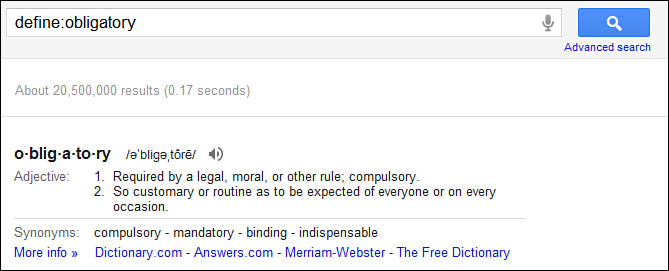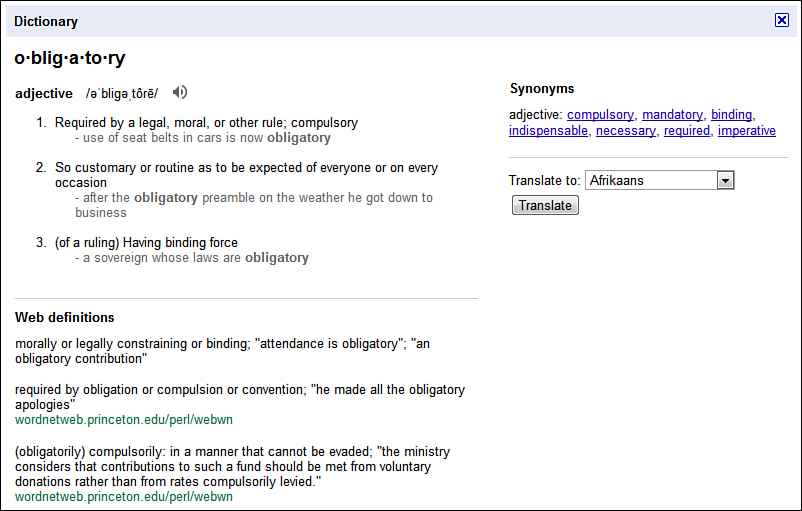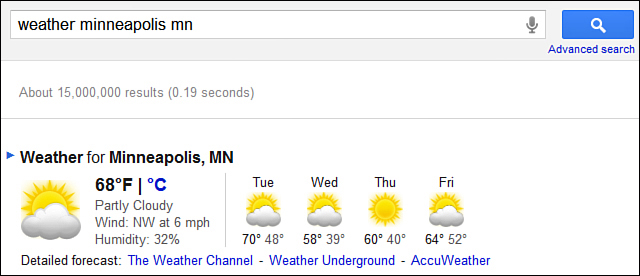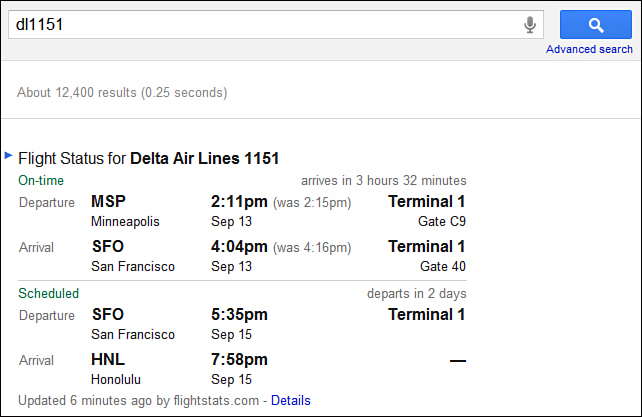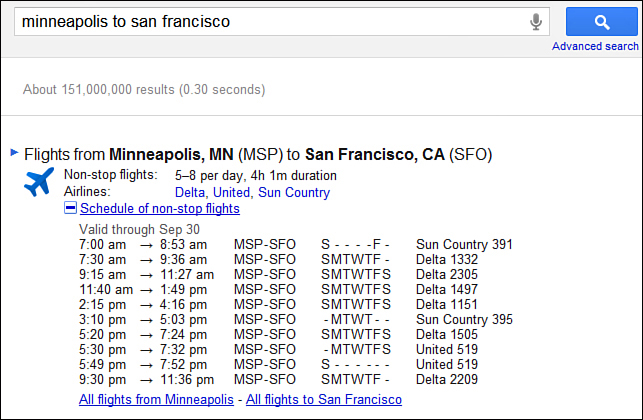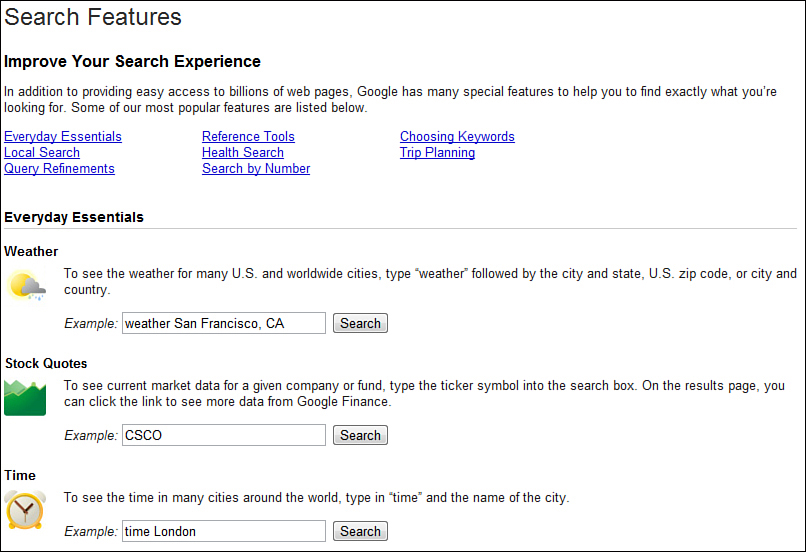Using Google’s Special Search Features
Google is a great search engine, there’s no denying that. But did you know that you can use Google for more than just searching the Web? That’s right, Google offers many different kinds of searches—some of them quite useful, others a bit more obscure.
What kinds of searches are we talking about? How about searching for word definitions? Or information about an airline flight? Or mathematical constants and conversions?
That’s right—Google can do all this and more. Read on to learn all about these special functions—and how to use them.
 TELL ME MORE Media 4.1—Why Does Google Offer These Special Search Features?
TELL ME MORE Media 4.1—Why Does Google Offer These Special Search Features?
If you’re curious as to why Google doesn’t stick with simple web searching, listen to the audio clip titled “Why Does Google Offer These Special Search Features?” on the companion Using website at http://www.quepublishing.com.
Searching for Definitions
Want to look up the definition of a particular word but don’t want to bother pulling out the old hardcover dictionary? Not sure of a specific spelling? Then use Google as an online dictionary to look up any word you can think of. It’s quite easy to do, using the define: operator.
To define a word, simply place the define: operator before the word in question, with no space between. For example, if you want to define the word “obligatory,” enter the query define:obligatory.
If you want to define a phrase, use the define: operator, and put the phrase in quotation marks. For example, to define the phrase “peer to peer,” enter the query define:“peer to peer”. Without the quotation marks, Google would define only the first word in the phrase.
Google now returns a standard search results page with a single web definition in a OneBox result at the top of the page. As you can see in Figure 4.1, this OneBox result includes a short definition of the word and a few useful links that point you to other definitions of the word elsewhere on the web.
Figure 4.1 The OneBox results of using the define: operator.
Click the More link in the definition to display the Dictionary page for the word in question. This page, like the one shown in Figure 4.2, includes several different definitions from web sources, synonyms, and more. It’s a good source of in-depth word information.
Figure 4.2 A typical Google Dictionary page.
Searching for Facts
When you’re looking for hard facts, Google might be able to help. Yes, Google always returns a list of sites that match your specific query, but if you phrase your query correctly—and are searching for a fact that Google has pre-identified—you can get the precise information you need at the top of the search results page.
What types of information are we talking about? Fact-based information, such as birthdates, birthplaces, population, and so on. All you have to do is enter a query that states the fact you want to know. For example:
• To find the population of San Francisco, enter what is population of san francisco.
• To find out where Mark Twain was born, enter where was mark twain born.
• To find out when President Barack Obama was born, enter what is birthday of barack obama.
• To find when Raymond Chandler died, enter when did raymond chandler die.
The answers to these questions are displayed in a OneBox section at the top of your search results page, like the one shown in Figure 4.3. You get the “best guess” answer to your question, along with a Show Sources link. Click this link to discover which sources supplied the information in question.
Figure 4.3 An information OneBox.
This capability to display “quick answers to straightforward questions” is called Google Q&A. The information presented is typical reference information, the kind of stuff you might find in a desk reference or almanac. Google Q&A isn’t always consistent about the sources of this info, or about the specific facts that display. For example, searching for distance to mars returns no quick fact; neither does height empire state building or size football field. So accept what you get, and recognize that Google is selective about the facts it knows.
Searching for Weather Information
Did you know that Google can be used to find and display current weather conditions and forecasts? It’s a pretty easy search; all you have to do is enter the keyword weather, followed by the location. You can enter the location as a city name, city plus state, or zip code. For example, to view the weather forecast for Minneapolis, enter weather minneapolis.
As you can see in Figure 4.4, Google displays current weather conditions and a 4-day forecast at the top of the search results page. Although this is a good summary report, you may want to click through to the more detailed forecasts offered by the online weather services lined to at the bottom of the OneBox.
Figure 4.4 Google’s weather search results.
Searching for Travel Information
Weather information is important to travelers, as is information about flight delays and such. Fortunately, you can use the main Google search page to search for this information, just as you did with weather forecasts.
All you have to do is enter a flight number into the Google search box. For example, to find out the status of Delta flight 1151, enter dl1151. As you can see in Figure 4.5, Google displays the real-time status of the specified flight, courtesy of the FlightStats website (www.flightstats.com). Click the Details link to view even more detailed flight information.
Figure 4.5 Viewing flight information.
If, on the other hand, you’re looking for a flight, Google can help you there, too. Just enter the query flights from city1 to city2 and Google displays a summary of available flights. Click the + link to view the full schedule of non-stop flights, like the one in Figure 4.6.
Figure 4.6 Viewing scheduled flights from Minneapolis to San Francisco.
Searching for Numbers
Airline flights aren’t the only numbers you can look up with Google. Google enables you to enter all sorts of numbers into its main search page and then displays the relevant information at the top of the search results page.
For example, if you want to track a package that was sent via UPS, all you have to do is enter the UPS tracking number. If you want to see what product is attached to a specific UPC (universal product code), just enter the bar code number. If you have a ZIP code and you want to know which city it serves, enter the ZIP code.
Table 4.1 details all the different types of numbers that Google can look up for you.
Table 4.1 Google Number Lookups
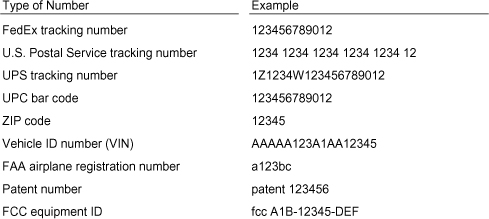
Searching for Solutions
Here’s something few Google users know. You can use Google as a calculator, and to perform conversions and look up constants. This is one of the coolest “hidden features” in the Google universe—and you’re reading about it here!
 SHOW ME Media 4.2—Using Google as a Calculator
SHOW ME Media 4.2—Using Google as a Calculator
To learn more about Google’s calculation functions, see the video titled “Using Google as a Calculator” on the companion Using website, http://www.quepublishing.com.
Performing Basic Calculations from the Google Search Box
To use Google as a calculator, all you need to do is enter your equation or formula into the search box and then click the Google Search button. The result of the calculation is displayed on the search results page, as shown in Figure 4.7. It’s that simple.
Figure 4.7 Using Google as a calculator.
You can use a number of algebraic operators to construct your calculations. Table 4.2 details the operators that Google recognizes.
Table 4.2 Google’s Basic Calculator Functions

Several functions have multiple operators you can use. For example, for addition you can use either +, plus, or and. That means you can add the numbers 2 and 3 in three different ways:
• 2 + 3
• 2 plus 3
• 2 and three
And you don’t need to enter spaces between the operator and the numbers (unless you’re spelling them out). So 2 + 3 is just as good a query as 2+3. Google’s smart enough to figure out what you mean.
Google also enables you to string multiple operations together. For example, if you want to calculate 12 times 5 divided by 4, enter 12 * 5 / 4. The calculations work from left to right, multiplying and dividing first, and then adding and subtracting. So, using another example, 2 + 3 * 3 equals 11, not 15.
You can also create nesting equations by using appropriately placed parentheses. So, to divide the sum of 4 plus 3 by the sum of 5 plus 2, you’d enter (4 + 3) / (5 + 2). You can get as complex or creative as you want; Google can handle it.
Performing Advanced Calculations
Google’s calculator isn’t limited to basic addition and multiplication. It can also handle more advanced calculations (detailed in Table 4.3), trigonometric functions (Table 4.4), inverse trigonometric functions (Table 4.5), hyperbolic functions (Table 4.6), and logarithmic functions (Table 4.7). If you know what these functions are, I assume you know the proper way to use them. If you don’t, get yourself a good math book, or don’t bother with them.
Table 4.3 Google’s Advanced Mathematic Functions

Table 4.4 Google’s Trigonometric Functions

Table 4.5 Google’s Inverse Trigonometric Functions

Table 4.6 Google’s Hyperbolic Functions

Table 4.7 Google’s Logarithmic Functions

Looking Up the Values of Constants
In addition to performing calculations, Google knows a variety of mathematical and scientific constants, such as pi, Avogadro’s number, and Planck’s constant. It also knows the radius of the Earth, the mass of the sun, the speed of light, the gravitational constant, and a lot more.
Now check this out. Not sure what the value of pi is? Enter pi, and Google returns 3.14159265, as shown in Figure 4.8. How about the speed of light? Enter speed of light, and Google returns 299,792,458 m/s. What about the radius of the Earth? Enter radius of earth, and Google returns 6378.1 kilometers.
Figure 4.8 The value of pi.
Now get fancy. Try dividing the radius of the Earth by pi. Enter (radius of earth) / pi; Google’s answer is 2030.21229 kilometers. Or how about multiplying the radius of the Earth by the speed of light and then dividing the answer by Avogadro’s number? I’m not sure why you’d want to do this, but the query looks like this: (radius of earth) * (speed of light) / (avogadros number). The answer is 3.17512678 * 10–9 m2/s.
And what constants does Google know? Here’s a short list, with shorthand entries in parentheses:
• Astronomical unit (au)
• Atomic mass unit (amu)
• Avogadro’s number
• Boltzmann constant (k)
• Electric constant (epsilon_0)
• Electron mass (m_e)
• Electron volt (eV)
• Elementary charge
• Euler’s constant
• Faraday constant
• Fine-structure constant
• Gravitational constant (G)
• Magnetic flux quantum
• Mass of moon (m_moon)
• Mass of planet (m_planet, as in m_earth)
• Mass of sun (m_sun)
• Molar gas constant (R)
• Pi
• Planck’s constant (h)
• Proton mass (m_p)
• Radius of moon (r_moon)
• Radius of planet (r_planet, as in r_mars)
• Radius of sun (r_sun)
• Rydberg constant
• Speed of light (c)
• Speed of sound
• Stefan-Boltzmann constant
For example, if you wanted to find the speed of light, you could enter speed of light, or you could just enter a capital C. Google knows the value both ways.
Converting Units of Measure
Another surprise is that Google’s also handles conversions. It knows miles and meters, furlongs and light-years, seconds and fortnights, and even angstroms and smoots—and it can convert from one unit of measurement to another.
The key to using the Google calculator as a converter is to express your query using the proper syntax. In essence, you want to start with the first measure, followed by the word “in,” followed by the second unit of measure. A general query looks like this: x firstunits in secondunits.
 SHOW ME Media 4.3—Using Google for Conversions
SHOW ME Media 4.3—Using Google for Conversions
To learn more about Google’s conversion functions, see the video titled “Using Google for Conversions” on the companion Using website, http://www.quepublishing.com.
Now look at some examples.
Don’t know how many feet equal a meter? Enter the query 1 meter in feet; the result is shown in Figure 4.9. Not sure how many teaspoons are in a cup? Enter 1 cup in teaspoons. Want to convert 100 U.S. dollars into euros? Enter 100 usd in euros. Or how about converting 72 degrees Fahrenheit to Celsius? Enter 72 degrees Fahrenheit in Celsius. Or maybe you want to find out your weight in kilos, or your age in seconds. Enter the queries 180 pounds in kg or 45 years in seconds.
Figure 4.9 Converting meters to feet.
All the formulas necessary for these types of conversions are hardwired into the Google search engine. Just state your query as clearly as possible, and Google does the rest.
What units of measure does Google know? Table 4.8 lists just some of what you can find when you search Google.
Table 4.8 Google’s Units of Measure
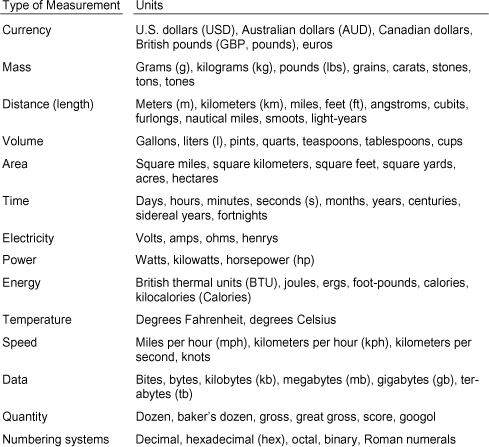
Google even enables you to do some nonsensical conversions. You can query speed of light in knots or 1 foot in smoots. You can also use these conversions to create nonsense calculations, such as (radius of earth) / 3 teaspoons. It doesn’t make any sense, but Google can do it. (And you get the wonderfully absurd measurement of “kilometers per liter.”)
More Google Search Features
Want a quick way to access these and other specialized search features? Then go directly to www.google.com/help/features.html. This displays Google’s Search Features page, as shown in Figure 4.10. From here you can access the following information, just by filling in the blanks and clicking the appropriate Search button:
Figure 4.10 Using Google Search Features page.
• Weather
• Stock quotes
• Time
• Sports scores
• Sunrise and sunset
• Calculator
• Book search
• Earthquakes
• Unit conversion
• Public data
• People profiles
• Synonym search
• Dictionary definitions
• Spell checker
• Local search
• Movie showtimes
• Health conditions
• Poison control
• Suicide prevention
• Flu vaccine finder
• Flight tracking
• Currency conversion
• Maps
• Query refinements (+ operator, related search, fill in the blank)
• Package tracking
• Patent numbers
 SHOW ME Media 4.4—Using Google’s Search Features Page
SHOW ME Media 4.4—Using Google’s Search Features Page
To learn more about the Search Features page, see the video titled “Using Google’s Search Features Page” on the companion Using website, http://www.quepublishing.com.

